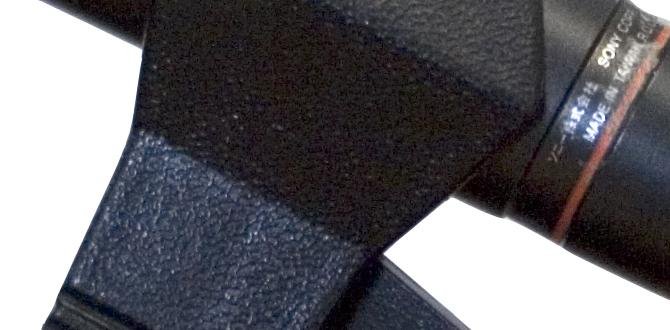Quick Summary: Unlock genius savings on your electricity bill by mastering your TV’s energy consumption using your remote control. Simple adjustments and mindful habits can significantly reduce wasted power, making your home entertainment more eco-friendly and cost-effective.
Hey there, home entertainment fans! Bob E Riley here from Aimguider. Ever feel like your TV is silently sipping electricity even when it’s off? It’s a common worry, and honestly, it can be a bit frustrating to think about wasted energy and money. But here’s some good news: you actually have a lot of power – right in your hand! Your trusty TV remote isn’t just for changing channels; it’s your key to unlocking smarter energy use. We’re going to dive deep into how you can use that little device to make a real difference in your TV’s energy consumption. Get ready to learn some simple, effective tricks that will save you money and help the planet.
Understanding Your TV’s Energy Footprint: Beyond the Screen
When we think about how much electricity our TVs use, we usually focus on when the screen is on and bright. And yes, that’s the biggest chunk of energy usage. But did you know that even when your TV appears to be “off,” it can still be drawing power? This is commonly known as “phantom load” or “standby power.” It’s the energy needed to power the remote control receiver, maintain memory for settings, and allow for quick startup when you hit the power button on your remote. While a single TV’s phantom load might seem tiny, think about how many TVs are in homes, offices, and other places – it adds up to a significant amount of wasted energy nationwide. Learning to manage this standby power is a crucial step in an energy-conscious household.
The primary culprit for this standby power is often the TV’s advanced features designed for convenience. Things like “quick start” or “instant on” modes mean the TV isn’t fully powering down. Similarly, network-connected TVs that allow for smart features, app updates, and remote access also need a constant trickle of power to stay connected to your home network. While these features are fantastic for user experience, they come at a cost to your electricity bill and the environment. Thankfully, your remote control often holds the keys to managing these power-hungry settings without sacrificing too much convenience.
For those looking for more in-depth information on standby power, the U.S. Department of Energy provides some excellent resources. They explain how much energy devices can consume while in standby mode and offer tips for reducing it. You can check out their findings on energy saving for home electronics to get a broader perspective.
Phantom Load: The Silent Energy Drain
Imagine a faucet that’s not quite turned off, just a tiny drip, drip, drip. That’s a good way to visualize phantom load. Even when your TV is “off” and the screen is black, some internal components are still active, eagerly waiting for a signal from your remote control. This allows your TV to wake up instantly when you press the power button on your remote, a feature many of us have come to expect. However, this constant state of readiness consumes electricity. While individual devices might only use a few watts, when you multiply that across all the electronics in your home – not just TVs, but also game consoles, chargers, microwaves, and more – the energy waste becomes substantial.
The amount of energy consumed by phantom load varies greatly depending on the TV model and its features. Newer, “smart” TVs, especially those with built-in Wi-Fi and advanced connectivity options, tend to consume more standby power than older, simpler models. This is because they need to maintain network connections and power for operating systems even when they’re not actively in use. Manufacturers often provide energy consumption information, but it’s not always easy to find or understand for the average consumer.
Why It Matters: Saving Money and the Planet
Reducing your TV’s energy consumption isn’t just about being eco-friendly, although that’s a significant benefit. It’s also about practical, everyday savings. Electricity bills can be a substantial part of household expenses. By taking small, manageable steps to cut down on phantom load and optimize your TV’s usage, you can see a noticeable difference in your monthly costs. Over time, these savings can add up to hundreds of dollars annually. Furthermore, every kilowatt-hour of electricity saved means less demand on power plants, which often rely on fossil fuels, thus reducing greenhouse gas emissions and contributing to a healthier planet. It’s a win-win situation: you save money, and we all benefit from a cleaner environment.
Your Remote Control: The Power to Save
Your remote control is the direct interface to your TV’s settings, and many of them are designed with energy efficiency in mind. Manufacturers are increasingly aware of the need to reduce power consumption, both to meet regulatory standards and to appeal to environmentally conscious consumers. This means that most modern TV remotes can unlock features that help manage energy usage. The key is knowing where to find these settings within your TV’s menu system.
The exact location and naming of these energy-saving options can differ significantly between TV brands and models. However, they are almost always found within the TV’s main settings or setup menu. Look for sections related to General Settings, System, Power Management, Eco Settings, Energy Saving, or similar. Don’t be afraid to explore each menu option; you’re unlikely to break anything, and you might discover useful features you never knew existed. Once you identify these settings, you can make informed choices about how your TV conserves power.
Navigating Your TV’s Menu for Savings
The journey to energy savings begins with understanding your TV’s on-screen menu. Most modern TVs have a dedicated settings or setup button on the remote, often represented by a gear icon or the word “Menu” or “Settings.” Pressing this button will bring up a series of options on your screen. You’ll typically find categories like Picture, Sound, Network, System, and General Settings. For energy-saving features, you’ll want to look for categories like:
- Power Management: This is a common place to find options related to standby power, auto-power off, and screen brightness when not in use.
- Eco Settings: Many TVs use “Eco” as a shorthand for ecological or energy-saving features. This section might include brightness adjustments, power-saving modes, and even ambient light sensors that adjust screen brightness based on the room’s lighting.
- General Settings / System: Sometimes, energy-saving options are integrated into more general system controls, such as quick start modes or network standby settings.
- Advanced Settings: If you don’t find what you’re looking for in the basic menus, sometimes more granular controls are hidden within advanced or expert settings.
Take your time to explore these menus. You might find that adjusting a few simple settings can make a surprising difference in your TV’s overall energy consumption. Remember, every TV is a little different, so don’t get discouraged if the names aren’t exactly what I’ve listed here. The important thing is to look for terms related to power or eco-friendliness.
Key Settings to Look For and Adjust
Once you’ve navigated to the relevant menu sections, here are the most impactful settings you should look for and consider adjusting:
- Standby Power / Eco Mode: This is your prime target for reducing phantom load. Many TVs offer different levels of standby power, from “Normal” to “Low” or “Off” (or “Eco Mode”). Selecting a lower standby power setting means the TV isn’t as “ready” to turn on instantly, but it will use significantly less energy when off. Some TVs might even allow you to completely disable standby power, requiring you to use a power strip to turn the TV on its main switch.
- Quick Start / Instant On: This feature keeps more of the TV’s components powered up to speed up startup time. While convenient, disabling this can significantly reduce standby power consumption. The TV will take a few seconds longer to turn on, but the energy savings during that time are worth it.
- Auto Power Off: Most TVs have a setting that will automatically turn off the TV after a certain period of inactivity (e.g., 15 minutes, 30 minutes, 1 hour). Make sure this is enabled and set to a duration that works for you. This is especially useful if you tend to fall asleep watching TV!
- Brightness and Contrast: While primarily affecting picture quality, extremely high brightness and contrast settings can also increase energy consumption when the TV is on. While you don’t want to compromise your viewing experience too much, reducing these settings slightly, especially in a dimly lit room, can contribute to energy savings. Some TVs have an “Eco” or “Power Saving” picture mode that does this automatically.
- Screen Saver / Auto Dim: Some TVs offer features that dim the screen or display a screen saver after a period of inactivity or when the input signal is lost. Enabling these can prevent the TV from unnecessarily drawing full power.
- Network Standby / Wi-Fi Standby: For smart TVs, this setting controls whether the TV stays connected to your network when it’s off to enable features like “wake on LAN” or app updates. Disabling this will reduce standby power, but you’ll need to manually reconnect your TV to Wi-Fi each time you want to use its smart features.
Remember, the best settings for you depend on your priorities. If absolute maximum energy savings are your goal, you might disable “Quick Start” and put the TV into its lowest “Standby Power” mode. If you value convenience and instant access, you might opt for less aggressive settings. It’s often a balancing act, but by making informed choices, you can find the sweet spot.
Practical Strategies for TV Energy Consumption
Beyond tweaking settings, there are simple habits you can adopt to drastically cut down on your TV’s energy usage. These are easy to implement and, when combined with menu adjustments, can lead to significant savings and a more environmentally friendly viewing experience.
1. The Power of the Power Strip
This is one of the most effective ways to combat phantom load, especially if your TV doesn’t offer a truly “off” standby mode or if you want to be absolutely sure no power is being used. A smart power strip, or even a basic one with a manual on/off switch, allows you to shut off power to your TV and all connected devices (like soundbars, streaming boxes, and game consoles) simultaneously. When you’re done watching, simply flip the switch on the power strip. This completely cuts off the electrical supply and eliminates phantom load for all connected devices.
For ultimate convenience with smart TVs, you can even use a “smart” power strip that can be controlled via an app or voice assistant. This way, you can turn everything off with a command even if you’re not near the power strip itself. Some people go a step further and plug their TV into a surge protector that has a physical main switch, or even just directly into a wall outlet that they can access easily and switch off.
Check out resources like Energy.gov’s guide on power strips for more detailed information on how they work and why they are so effective at saving energy.
2. Unplugging When You’re Away
If you’re going to be away from home for an extended period, such as on vacation, unplugging your TV is a surefire way to ensure it’s not consuming any energy. While this might seem obvious, many people forget that even when “off,” their TVs can still be drawing power. This practice is especially important for older TVs that might have less efficient standby modes or for any electronics you don’t plan to use for a while. It’s a simple action with a guaranteed energy-saving result.
3. Mindful Viewing Habits
Your own viewing habits can also play a role. Here are a few ideas:
- Avoid “Leaving It On”: Resist the urge to have the TV on as background noise if no one is actively watching it. Even a bright screen displaying a static image or a muted program uses energy.
- Use Timers Wisely: As mentioned before, the auto-power-off timer is your friend. Set it to a reasonable time (e.g., 30 minutes or an hour) to ensure the TV turns itself off if you’ve fallen asleep or simply forgotten to switch it off.
- Reduce Screen Time When Possible: This is a broader lifestyle suggestion, but every hour the TV is off is an hour it’s not consuming electricity. Consider alternative activities like reading, playing games, or spending time with family.
Understanding Energy Ratings and Labels
When you’re in the market for a new TV, or even just curious about your current one, understanding energy labels can provide valuable insights into its power consumption. These labels are often mandated by governments and aim to give consumers a clear, comparable picture of a product’s energy efficiency.
The EnergyGuide Label (or Equivalent)
In many countries, appliances, including TVs, come with an energy rating label. In the United States, this is commonly known as the EnergyGuide label. This label typically shows:
- An estimate of the yearly energy consumption in kilowatt-hours (kWh).
- An estimated yearly operating cost (based on average electricity rates).
- A comparison to similar models, indicating whether the TV is more or less energy efficient than others.
This is an invaluable tool when comparing different TV models. A TV that looks great and has all the features you want might be significantly more or less energy-efficient than a competitor. Don’t just look at the price tag; consider the long-term operating cost.
ENERGY STAR Certification
Look for the ENERGY STAR label. This is a government-backed program that certifies products that are more energy-efficient than standard models. ENERGY STAR certified TVs are designed to use less energy in both active use and standby mode. When purchasing a new TV, prioritizing ENERGY STAR certified models is an excellent way to ensure you’re investing in a device that’s designed for efficiency from the ground up. You can learn more about the ENERGY STAR program directly from the official ENERGY STAR website.
Comparing TV Technologies for Energy Efficiency
The type of display technology your TV uses can also impact its energy consumption. While advancements are constantly being made, here’s a general overview:
| TV Technology | Typical Energy Efficiency | Notes |
|---|---|---|
| LED (LCD with LED backlight) | Good | Generally more efficient than older LCDs and Plasmas. Brightness and local dimming features can affect consumption. |
| OLED | Very Good to Excellent | Can be highly efficient, especially with darker scenes, as pixels are individually lit and can turn off completely. Brighter scenes consume more power. |
| QLED | Good to Very Good | A type of enhanced LED-LCD. Efficiency is comparable to standard LED, with improvements in brightness and color. Consumption can increase with higher brightness. |
| Plasma (Older Technology) | Poor | Generally the least efficient, consuming significantly more power than LED or OLED. Usually found in older televisions. |
It’s important to remember that while technology plays a role, how you use your TV and the settings you choose will have a direct impact on how much energy it consumes, regardless of its underlying technology. Always prioritize adjusting those settings for the best immediate impact.
Troubleshooting Common Energy Consumption Issues
Sometimes, even after trying to apply energy-saving settings, you might still suspect your TV is using more power than it should. Here are a few common troubleshooting steps:
- Check for Stuck Updates: Occasionally, a TV might get stuck in a processing loop trying to update firmware or apps, consuming extra power. Try a full power cycle: unplug the TV from the wall, wait 60 seconds, and plug it back in.
- Factory Reset: If you’ve made many settings changes and aren’t sure what’s causing higher consumption, a factory reset can sometimes resolve software glitches that might be affecting power management. Be sure to back up any important settings or note down your preferred picture settings before doing this.
- Review Connected Devices: Ensure that connected devices like HDMI peripherals or USB drives aren’t drawing excessive power or preventing the TV from entering a low-power state. Try disconnecting them one by one to see if it makes a difference.
- Firmware Updates: Make sure your TV’s firmware is up to date. Manufacturers often release updates that include improvements to power management and energy efficiency. Check your TV’s settings menu for a “Software Update” or “Firmware Update” option.
Frequently Asked Questions About TV Energy Consumption and Your Remote
Q1: Can my TV remote really help me save money on my electricity bill?
A1: Absolutely! Your remote control is the gateway to your TV’s settings. By using it to adjust power-saving features, you can reduce unnecessary energy use, which directly translates to lower electricity bills.
Q2: What is “phantom load” and how does my remote control relate to it?</p






